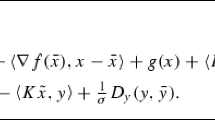Abstract
We show that most interior-point algorithms for linear programming generate a solution sequence in which every limit point satisfies the strict complementarity condition. These algorithms include all path-following algorithms and some potential reduction algorithms. The result also holds for the monotone complementarity problem if a strict complementarity solution exists. In general, the limit point is a solution that maximizes the number of its nonzero components among all solutions.
Similar content being viewed by others
References
K.M. Anstreicher and R.A. Bosch, “Long steps in an O(n 3 L) algorithm for linear programming,”Mathematical Programming 54 (1992) 251–265.
K.M. Anstreicher, D. den Hertog, C. Roos and T. Terlaky, “A long step barrier method for convex quadratic programming,” Technical Report, Faculty of Technical Mathematics and Computer Science, Delft University of Technology (Delft, The Netherlands, 1990).
E.R. Barnes, “A variation on Karmarkar's algorithm for solving linear programming problems,”Mathematical Programming 36 (1986) 174–182.
I.I. Dikin, “Iterative solution of problems of linear and quadratic programming,”Soviet Mathematics Doklady 8 (1967) 674–675.
R.M. Freund, “Polynomial-time algorithms for linear programming based only on primal scaling and projected gradients of a potential function,”Mathematical Programming 51 (1991) 203–222.
A.J. Goldman and A.W. Tucker, “Theory of linear programming,” in: H.W. Kuhn and A.W. Tucker, eds.,Linear Inequalities and Related Systems (Princeton University Press, Princeton, NJ, 1956) pp. 53–97.
C.C. Gonzaga, “An algorithm for solving linear programming problems in O(n 3 L) operations,” in: N. Megiddo, ed.,Progress in Mathematical Programming — Interior Point and Related Methods (Springer, New York, 1989) pp. 1–28.
C.C. Gonzaga, “Large step path-following methods for linear programming, Part I: Barrier function method,”SIAM Journal on Optimization 1 (1991) 268–279.
C.C. Gonzaga, “Large step path-following methods for linear programming, Part II: Potential reduction method,”SIAM Journal on Optimization 1 (1991) 280–292.
C.C. Gonzaga and M.J. Todd, “An O(\(\sqrt n \) L)-iteration large-step primal—dual affine algorithm for linear programming,” to appear inSIAM Journal on Optimization.
O. Güler, “Existence of interior points and interior paths in nonlinear monotone complementarity problems,” to appear inMathematics of Operations Research.
O. Güler, “Path following and potential reduction algorithms for nonlinear monotone complementarity problems,” in preparation.
N. Karmarkar, “A new polynomial-time algorithm for linear programming,”Combinatorica 4 (1984) 373–395.
M. Kojima, N. Megiddo and S. Mizuno, “Theoretical convergence of large-step primal—dual interior point algorithms for linear programming,”Mathematical Programming 59 (1993) 1–21.
M. Kojima, Y. Kurita and S. Mizuno, “Large-step interior point algorithms for linear complementarity problems,” Research Report, Department of Information Sciences, Tokyo Institute of Technology (Tokyo, Japan, 1991).
M. Kojima, S. Mizuno and A. Yoshise, “An O(\(\sqrt n \) L) iteration potential reduction algorithm for linear complementarity problems,”Mathematical Programming 50 (1991) 331–342.
M. Kojima, S. Mizuno and A. Yoshise, “A polynomial-time algorithm for a class of linear complementarity problems,”Mathematical Programming 44 (1989) 1–26.
M. Kojima, S. Mizuno and A. Yoshise, “A primal—dual interior point method for linear programming,” in: N. Megiddo, ed.,Progress in Mathematical Programming — Interior Point and Related Methods (Springer, New York, 1989) pp. 29–47.
S. Liu and D. Goldfarb, “Interior point potential function reduction algorithms for solving convex quadratic programs,” manuscript, Department of IEOR, Columbia University (New York, 1989).
L. McLinden, “An analogue of Moreau's proximation theorem, with applications to the nonlinear complementarity problem,”Pacific Journal of Mathematics 88 (1980) 101–161.
L. McLinden, “The complementarity problem for maximal monotone multifunctions,” in: R.W. Cottle, F. Giannesi and J.L. Lions, eds.,Variational Inequalities and Complementarity Problems (Wiley, New York, 1980) pp. 251–270.
K.A. McShane, C.L. Monma and D.F. Shanno, “An implementation of a primal—dual interior point method for linear programming,”ORSA Journal on Computing 1 (1989) 70–83.
N. Megiddo, “Pathways to the optimal set in linear programming,” in: N. Megiddo, ed.,Progress in Mathematical Programming — Interior Point and Related Methods (Springer, New York, 1989) pp. 131–158.
S. Mizuno, M.J. Todd and Y. Ye, “On adaptive-step primal—dual interior-point algorithms for linear programming,” to appear inMathematics of Operations Research.
R.C. Monteiro and I. Adler, “Interior path following primal—dual algorithms. Part I: Linear programming,”Mathematical Programming 44 (1989) 27–41.
R.C. Monteiro and I. Adler, “Interior path following primal—dual algorithms. Part II: Convex quadratic programming,”Mathematical Programming 44 (1989) 43–66.
R.C. Monteiro and I. Adler, “An extension of Karmarkar type algorithm to a class of convex separable programming problems with global linear rate of convergence,”Mathematics of Operations Research 15 (1990) 408–422.
Yu.E. Nesterov and A.S. Nemirovsky,Self Concordant Functions and Polynomial Time Methods for Smooth Convex Programming (Moscow, USSR, 1989).
J. Renegar, “A polynomial-time algorithm, based on Newton's method, for linear programming,”Mathematical Programming 40 (1988) 59–93.
C. Roos and J-Ph. Vial, “A polynomial method of approximate centers for linear programming,”Mathematical Programming 54 (1992) 295–305.
A. Schrijver,Theory of Linear and Integer Programming (Wiley, New York, 1986).
K. Tanabe, “Complementary-enforcing centered Newton method for mathematical programming,” in: K. Tone, ed.,New Methods for Linear Programming (The Institute of Statistical Mathematics, Tokyo, Japan, 1987) pp. 118–144.
M.J. Todd, “A low complexity interior-point algorithm for linear programming,” Technical Report No. 903, School of ORIE, Cornell University (Ithaca, NY, 1990).
P. Tseng, “Complexity analysis of a linear complementarity algorithm based on Lyapunov function,”Mathematical Programming 53 (1992) 297–306.
P.M. Vaidya, “An algorithm for linear programming which requires O(((m+n)n 2+(m+n)1.5 n)L) arithmetic operations,”Mathematical Programming 47 (1990) 175–202.
R.J. Vanderbei, M.S. Meketon and B.A. Freedman, “A modification of Karmarkar's linear programming algorithm,”Algorithmica 1 (1986) 395–407.
Y. Ye, K.O. Kortanek, J.A. Kaliski and S. Huang, “Near boundary behavior of primal—dual potential reduction algorithms for linear programming,”Mathematical Programming 58 (1992) 243–255.
Y. Ye, “An O(n 3 L) potential reduction algorithm for linear programming,”Mathematical Programming 50 (1991) 239–258.
Y. Zhang, R.A. Tapia and J.E. Dennis, “On the superlinear and quadratic convergence of primal—dual interior point linear programming algorithms,” to appear inSIAM Journal on Optimization.
Author information
Authors and Affiliations
Additional information
Research supported in part by NSF Grant DDM-8922636, the Iowa Business School Summer Grant, and the Interdisciplinary Research Grant of the University of Iowa Center for Advanced Studies.
Rights and permissions
About this article
Cite this article
Güler, O., Ye, Y. Convergence behavior of interior-point algorithms. Mathematical Programming 60, 215–228 (1993). https://doi.org/10.1007/BF01580610
Received:
Revised:
Issue Date:
DOI: https://doi.org/10.1007/BF01580610



